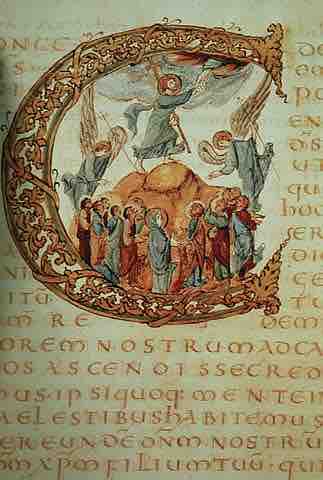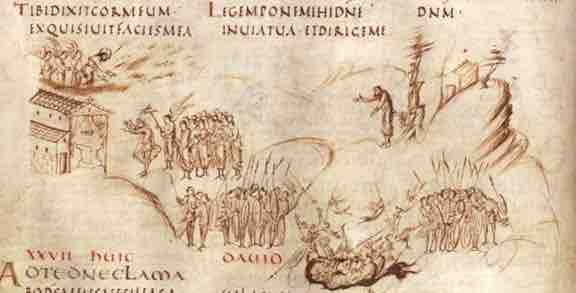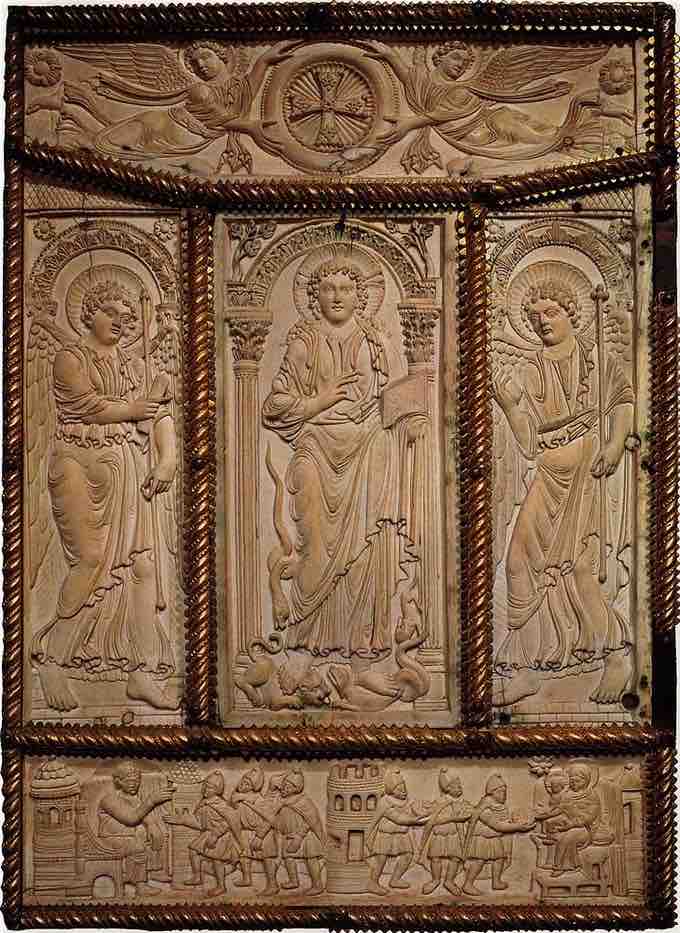Illuminated manuscripts are the most numerous surviving works of the Carolingian era. A number of luxury manuscripts, mostly Gospel books, have survived. They are decorated with a relatively small number of full-page miniatures, often including evangelist portraits and lavish canon tables, following the precedent of Insular art in Britain and Ireland. Carolingian narrative images and cycles are rarer, but many do exist. They tend to be mostly of the Old Testament, while New Testament scenes are more often found on the ivory reliefs on the covers. Carolingian illustrators adopted the over-sized and heavily decorated initials of Insular art and further developed the historiated decorated initial to produce small narrative scenes seen for the first time towards the end of the period, most notably in the Drogo Sacramentary (850-855). The historiated initial would have influence into the Romanesque period and were a harmonious union of classical lettering with figural scenes.

Drogo Sacramentary
Drogo Sacramentary (c. 850): depicts a historiated initial "C" which contains the Ascension of Christ. The text is in gold ink.
Carolingian luxury manuscripts were given treasure bindings or rich covers with jewels set in gold and carved ivory panels, and, as in Insular art, were prestige objects kept in the church or treasury. This was different from the working manuscripts that were kept in libraries, where some initials might be decorated and pen drawings added in a few places. The Utrecht Psalter stands alone as a very heavily illustrated library version of the Psalms, done in pen and wash, and almost certainly copied from a much earlier manuscript. This manuscript was perhaps the most important of all Carolingian manuscripts for its innovative and naturalistic figure line drawings that were to become the most influential innovation of Carolinian art in later periods.

Ultrecht Psalter
From the Utrecht Psalter, ninth century. Naturalistic and energetic figurine line drawings were entirely new, and were to become the most influential innovation of Carolinian art in later periods.
Carolingian manuscripts are presumed to have been produced largely or entirely by clerics in a few workshops around the Carolingian Empire. Each of these workshops practiced its own style that developed based on the artists and influences of that particular location and time. The earliest workshop was the Court School of Charlemagne, then the Rheimsian workshop (which became the most influential of the Carolingian period), the Touronian style, the Drogo style, and the Court School of Charles II (the Bald).
The Court School of Charlemagne (also known as the Ada School) produced the earliest manuscripts, including the Godescalc Evangelistary (781–783), the Lorsch Gospels (778–820, ), the Ada Gospels, the Soissons Gospels, the Harley Golden Gospels (800-820), and the Vienna Coronation Gospels. The Court School manuscripts were ornate and elaborate: reminiscent of sixth-century ivories and mosaics from Ravenna, Italy. The Court School of Charlemagne initiated a revival of Roman classicism, yet still maintained Migration-Period artistic (Merovingian and Insular) traditions in their linear presentation, with no concern for volume and spatial relationships.

Lorsch Gospels
Ivory book cover. The Lorsch Gospels reflect its origin in the Court School of Charlemagne with its Late Antiquity Imperial scenes adapted to a Christian theme.
In the early ninth century, Archbishop Ebbo of Rheims assembled clerical artists and transformed Carolingian art. The expressive animations of the Rheims School would have influence on northern medieval art for centuries to follow, far into the Romanesque period. One example was the Gospel Book of Ebbo (816–835), painted with swift, fresh and vibrant brush strokes, evoking an inspiration and energy unknown in classical Mediterranean forms. This vibrant emotionalism was new to Caroligian art, as well. Figures in the Ebbo Gospels are represented in nervous, agitated poses. The illustration uses an energetic, streaky style with swift brush strokes. The style directly influenced manuscript illumination for decades, as seen in the Codex Aureus of St. Emmeram. Commentators have noted the similarity between the Utrecht Psalter and the Ebbo Gospels. The evangelist portrait of Matthew in the Ebbo Gospels is similar to the illustration of the psalmist in the first psalm of the Utrecht Psalter.
Saint Matthew, from the Ebbo Gospels (816-835)
The wavy lines that form the details on Matthew's clothing and the diagonal lines adding detail to the background and foreground are examples of the energetic subject matter in the Ebbo Gospels.
Other books associated with the Rheims school include the Utrecht Psalter and the Bern Physiologus (825-850), the earliest Latin edition of the Christian allegorical text on animals. Many of its miniatures are set, unframed, into the text block, which was a characteristic of Late-Antique manuscripts. For this reason, it is believed to be a copy of a fifth-century manuscript. It is one of the oldest extant illustrated copies of the Physiologus.
Bern Physiologus, Folio 12v (825-850).
The text and images from the Bern Physiologus are typical of Late-Antique manuscripts, leading scholars to believe that it is a copy of a fifth-century original.
Another style developed at the monastery of St. Martin of Tours, in which large Bibles were illustrated based on Late Antique Bible illustrations. Three large Touronian Bibles were created. One of the best examples was the Vivian Bible (c. 846), commissioned by Count Vivien, the lay abbot of St. Martin of Tours, and presented to Charles the Bald. The Tours School was cut short by the invasion of the Normans in 853, but its style had already left a permanent mark on other centers in the Carolingian Empire.
Finally Charles the Bald established a Court School that fused Touronian, Rhemsian, and Charlemagne Court School styles. Its location is uncertain, but several manuscripts are attributed to Charles the Bald's School, with the Codex Aureus of St. Emmeram (870) being the last and most spectacular. It was produced for Charles the Bald in 870 at his Court School. The school's location at the time is unknown, as its previous base at St Martin's Abbey in Tours was destroyed in 853, but it had probably moved to the Basilica of St. Denis outside Paris by the time of the production of the Codex. Seven full-page miniatures show the four evangelists, Charles the Bald enthroned, the Adoration of the Lamb and a Christ in Majesty.
Charles the Bald, from the Codex Aureus of St. Emmeram (c. 870).
Charles the Bald enthroned, surrounded by angels and saints. The Hand of God reaches down from beneath the red canopy, hovering over the emperor's head.